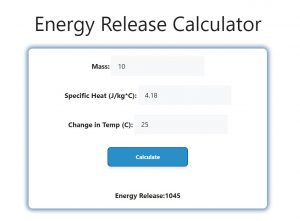About Energy Release Calculator (Formula)
Energy release plays a significant role in various scientific and engineering fields, particularly in thermodynamics. Understanding how much energy a substance releases during a temperature change is crucial for applications in chemistry, physics, and engineering. This article provides the energy release formula, a step-by-step guide on using the calculator, and answers to common questions about energy release calculations.
Formula
The formula for calculating energy release is as follows:
Energy release = Heat capacity × Change in temperature × Mass of substance
Where:
- Energy release is the total energy released (usually measured in joules or calories)
- Heat capacity is the amount of energy required to raise the temperature of the substance by one degree
- Change in temperature is the difference between the initial and final temperatures
- Mass of substance is the mass of the material undergoing the temperature change
How to Use
- Determine the heat capacity of the substance.
- Measure the change in temperature from the starting temperature to the final temperature.
- Input the mass of the substance into the calculator.
- The calculator will compute the total energy release based on these values.
Example
Let’s assume you have a substance with the following parameters:
- Heat capacity: 4.18 J/g°C
- Change in temperature: 25°C
- Mass of the substance: 10 grams
Using the formula, the energy release would be:
Energy release = 4.18 × 25 × 10
Energy release = 1,045 joules 
FAQs
- What is heat capacity?
Heat capacity is the amount of energy required to raise the temperature of a specific mass of a substance by one degree Celsius. - What is energy release?
Energy release refers to the amount of energy a substance gives off as it undergoes a change in temperature, often expressed in joules or calories. - How is change in temperature calculated?
Change in temperature is the difference between the final temperature and the initial temperature of the substance. - In what units is energy release measured?
Energy release is typically measured in joules (J) or calories (cal). - What factors affect energy release?
The main factors are the heat capacity, the change in temperature, and the mass of the substance. - Can I use this calculator for any substance?
Yes, as long as you know the heat capacity, temperature change, and mass, the calculator can be used for various substances. - How does heat capacity differ between materials?
Different materials require varying amounts of energy to change temperature, which is why their heat capacities vary. For example, water has a high heat capacity compared to metals. - What is the relationship between mass and energy release?
The greater the mass of the substance, the more energy is released for a given temperature change, assuming constant heat capacity. - What is specific heat capacity?
Specific heat capacity is the heat capacity per unit mass of a substance, often measured in joules per gram per degree Celsius (J/g°C). - Can this formula be applied to cooling as well as heating?
Yes, the formula works for both heating and cooling, as it calculates the energy released or absorbed during a temperature change. - Is the energy release always positive?
Energy release can be positive or negative, depending on whether the substance is releasing or absorbing energy (cooling or heating). - What is the difference between energy release and energy absorption?
Energy release occurs when a substance cools down, while energy absorption happens when it heats up. - What if I don’t know the heat capacity of a substance?
You will need to look up the heat capacity of the specific substance in tables or reference materials for accurate calculations. - Can this formula be used for phase changes (e.g., melting, boiling)?
No, phase changes involve latent heat, which is not accounted for in this formula. This formula applies only to temperature changes without a phase transition. - How accurate is the energy release calculation?
The accuracy depends on the precision of the input values for heat capacity, temperature change, and mass. - What are some practical applications of calculating energy release?
It is used in heating systems, chemical reactions, calorimetry, and thermal management in engineering systems. - Can I use this calculator for gases, liquids, and solids?
Yes, the calculator works for all states of matter, as long as the heat capacity is known. - What is the role of temperature in energy release?
The larger the temperature change, the more energy is either released or absorbed by the substance. - How do I convert energy units from joules to calories?
To convert joules to calories, divide the number of joules by 4.184, since 1 calorie equals 4.184 joules. - What is the significance of energy release in chemical reactions?
Energy release in chemical reactions indicates how much heat is given off or absorbed, helping to determine whether a reaction is exothermic (releases heat) or endothermic (absorbs heat).
Conclusion
Calculating energy release is crucial for understanding how substances behave when subjected to temperature changes. Using the formula involving heat capacity, temperature change, and mass, you can easily determine the energy released or absorbed by any material. This is especially useful in scientific and engineering applications where energy management is essential.
